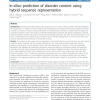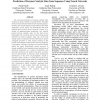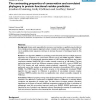39 search results - page 4 / 8 » Classification Comparison of Prediction of Solvent Accessibi... |
BMCBI
2010
13 years 7 months ago
2010
Background: Type III secretion system (T3SS) is a specialized protein delivery system in gramnegative bacteria that injects proteins (called effectors) directly into the eukaryoti...
BMCBI
2011
12 years 11 months ago
2011
Background: Intrinsically disordered proteins play important roles in various cellular activities and their prevalence was implicated in a number of human diseases. The knowledge ...
CIBCB
2007
IEEE
13 years 11 months ago
2007
IEEE
The accurate prediction of enzyme catalytic sites remains an open problem in bioinformatics. Recently, several structure-based methods have become popular; however, few robust seq...
BMCBI
2008
13 years 7 months ago
2008
Background: Amino acids responsible for structure, core function or specificity may be inferred from multiple protein sequence alignments where a limited set of residue types are ...
ICASSP
2007
IEEE
14 years 1 months ago
2007
IEEE
Protein structure prediction aims to determine the three-dimensional structure of proteins form their amino acid sequences. When a protein does not have similarity (homology) to a...



